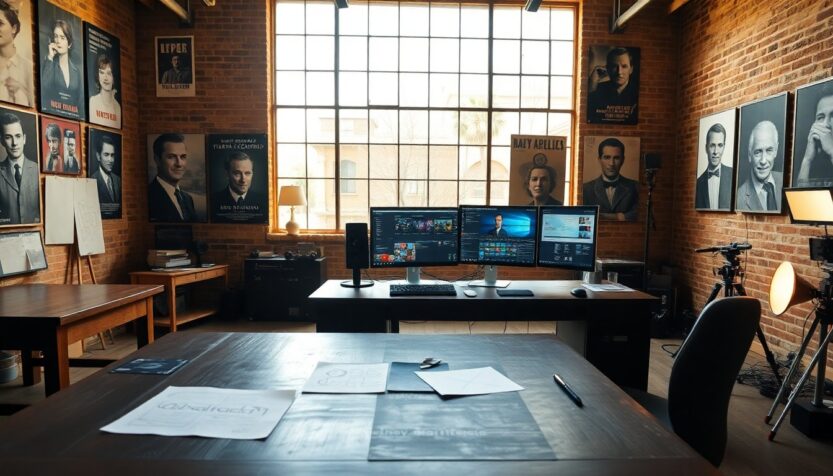In a historic soundstage in Los Angeles, Bryn Mooser draws inspiration from Hollywood’s vibrant history. Established in 1916 by producer Mack Sennett, this location has hosted legendary silent film star Mabel Normand and acclaimed directors such as Martin Scorsese and David Lynch. Mooser, a rising figure in the film industry, finds motivation in the legacy of those before him as he navigates the changing landscape of cinema.
The office serves as a hub where innovation intersects with tradition. Within its expansive 25,000-square-foot walls, Mooser’s team at Asteria is pioneering generative artificial intelligence in filmmaking. Here, echoes of past cinematic achievements blend seamlessly with the technology reshaping the industry.
The evolution of storytelling through technology
Mooser values Hollywood’s transformative journey, from the introduction of sound in films to the incorporation of color and modern narrative techniques. He reflects, “I wanted to work in a space that subconsciously reminds us of the industry’s technological evolution.” This perspective shapes the ethos of Asteria, positioning it as an artist-led film studio that aims to use AI as a tool to enhance storytelling rather than replace the creatives behind it.
Addressing copyright concerns
In an industry rife with apprehension surrounding AI, Mooser underscores the necessity of addressing copyright issues before generative AI can thrive. He and his team collaborated with Moonvalley, a tech start-up, to develop a new AI model named Marey, honoring French pioneer Étienne-Jules Marey. This model exclusively uses legally licensed material, allowing professional filmmakers to leverage its capabilities responsibly. Recently, Marey became accessible through multiple channels, including a partnership with Adobe to integrate it into Firefly and Premiere Pro.
AI’s impact on Hollywood’s future
The conversation surrounding AI in Hollywood has intensified, particularly following the controversy involving AI-generated actors. Recent discussions about AI “actor” Tilly Norwood sparked alarm among industry professionals, leading to debates on the ethical implications of AI in creative spaces. As concerns mount, voices like actor Bryan Cranston highlight the unease regarding the misuse of performers’ likenesses in AI-generated content.
Changing perceptions of AI
Mooser recognizes the challenges posed by the current environment but remains optimistic about AI’s potential to revolutionize the industry. He likens Asteria to a teaching hospital, where individuals unfamiliar with AI can discover its benefits. “Even those who initially express skepticism about AI leave with a newfound understanding,” he asserts, emphasizing the importance of education in overcoming fear and resistance.
Having been at the forefront of various technological shifts in filmmaking, Mooser’s enthusiasm is evident. He believes AI represents a significant advancement, perhaps larger than the introduction of computers. He encourages peers to learn about AI, framing it as an optional tool worth exploring rather than an obligatory element of the filmmaking process.
Innovative projects at Asteria
Mooser’s commitment to fostering creativity is evident in the projects underway at Asteria. Recent collaborations include a music video for Bad Bunny, featuring a creative use of generative AI to animate a frog character named Concho. This partnership allowed the animation team to produce a complex project efficiently while preserving the integrity of traditional artistry. Mooser emphasizes that AI enhances artists’ capabilities rather than replaces them.
Asteria has also announced an animated short film, ChikaBOOM!, with a star-studded voice cast, further showcasing the studio’s commitment to innovative storytelling. Mooser teases a top-secret animated film that promises to utilize AI to achieve significant cost savings, demonstrating how technology can disrupt conventional production methods.
Finding balance between tradition and innovation
As Asteria forges ahead, the studio remains focused on blending traditional filmmaking techniques with AI. Projects like Uncanny Valley, featuring Natasha Lyonne in her directorial debut, exemplify this balance. With a narrative exploring the potential consequences of augmented reality, the film underscores the necessity of preserving artistic integrity while embracing new technologies.
The office serves as a hub where innovation intersects with tradition. Within its expansive 25,000-square-foot walls, Mooser’s team at Asteria is pioneering generative artificial intelligence in filmmaking. Here, echoes of past cinematic achievements blend seamlessly with the technology reshaping the industry.0

